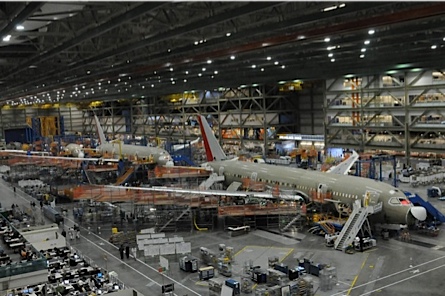Boeing has accelerated the pace of the 787 programme as it targets a first flight by the end of June. Key milestones required for the maiden sortie have been completed, but questions remain about the production ramp-up effort.
The airframer completed the factory gauntlet on 20 April, the first of three closed-loop simulations tests, marking the hand-off of 787 prototype "ZA001" to the flight-test team. Programme sources indicate that the factory "gauntlet test" was accomplished faster than anticipated.
In addition, the static-test airframe also conducted its third and final pre-first-flight requirement on 21 April, with the wings being flexed to limit load, ie 100% of the load expected to be seen in service. Boeing emphasises that analysis of the test, which saw the wings pushed 20-30% beyond limit load towards ultimate load, is ongoing, but appears positive.
 |
|---|
© Boeing |
Structural components for the first production aircraft - the seventh airframe that had been designated ZA007 but is now dubbed ZA100 - have begun arriving at the assembly line in Everett, Washington, and include the wings and aft fuselage. The designation for first production 787 was changed after Japanese airlines assumed control of many early delivery slots from Chinese carriers.
Other tests ahead for ZA001 in the near term include final landing-gear swing tests before it is moved to the flight line for the intermediate gauntlet trial, which will see the 787 fuelled for the first runs of the Hamilton Sundstrand APS 5000 auxiliary power unit and Rolls-Royce Trent 1000 engines.
Boeing says all hardware and software is ready to support a first flight later in the second quarter as currently scheduled, although some industry analysts are sceptical, suggesting that the event could slip in July.
Boeing chief executive Jim McNerney expressed confidence in the programme schedule during the company's quarterly earnings call on 22 April, as it progresses toward flight testing, roughly 22 months later than originally planned.
However, the airframer is still being pressed about its production ramp-up plan and whether or not its fragile supply chain can perform to the level of demand. Ron Epstein, analyst for Bank of America/Merrill Lynch recently questioned the plan, citing build times of over 300 days for centre fuselage sections by Global Aeronautica.
McNerney reaffirmed that Boeing's 50% purchase of the North Charleston, South Carolina facility has added "significant" production stability and the integrator is no longer a "bottleneck" for the programme. However, McNerney cautioned that Boeing is a year away from evaluating 787 production rates following the initial deliveries as it gauges global demand for the new long-range twinjet in the wake of the current economic turmoil, leaving the door open for a future readjustment.
Source: Flight International
















